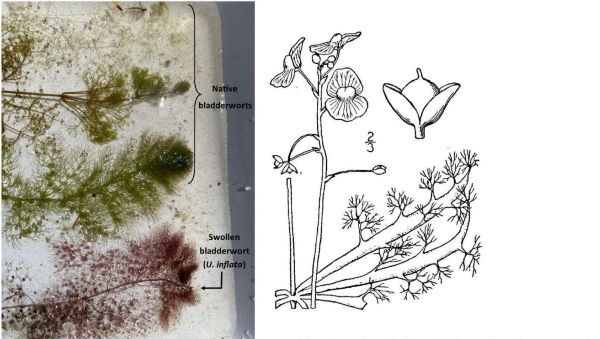Home → Water Quality → Monitoring → Invasives → Swollen Bladderwort
Swollen Bladderwort
Utricularia inflata

Photo: John McPhedran, Maine DEP. Drawing: Britton, N.L., and A. Brown. 1913.
Description
Swollen bladderwort (Utricularia inflata) is a free-floating, submerged plant native to The Atlantic and Gulf coastal plains, extending from southern New Jersey to Florida and westward to eastern Texas and southeastern Oklahoma. It has been introduced to parts of New England, New York, and the state of Washington. Like other Utricularia species, this plant is carnivorous and supplements nutrient intake by capturing small prey, such as zooplankton or small insects. Similar to the native Utricularia radiata, U. inflata has an emergent, yellow flower, supported by an inflated “pinwheel-like” raft of specialized leaves. The raft of U. inflata has 5-10 leaves in a whorl, measuring 3-10 cm (1-4 in), more than double the size of U. radiata. The snapdragon-like flowers typically grow in groups of 9-14, on stalks that grow 9-10 inches tall. Lower submerged leaves are alternately arranged with bladders dotting the branches throughout. Leaves can range between 2.54 cm-17.78 cm (1-7 inches).
General Information
Utricularia inflata is known to occur in all six New England states, New York, and has been found in Washington state. This species can be quite invasive, becoming dominant in ponds and displacing other native aquatic plants, and can be expected to continue expanding its range. The submersed vegetative parts of the plant overwinter under the ice and begin growing again in spring. U. inflata reproduces by fragmentation and seeds and can easily spread to new locations and new waterbodies. A small piece of the plant can be transported by fishing gear, boats, trailers, and duck hunting decoys. The submersed vegetative part of the plant overwinters under the ice and begins growing again in spring.